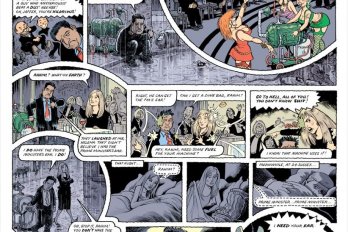Before we talk about Michael Cera, or Scott Pilgrim vs. the World, or Seth Rogen, or Loverboy, let’s talk about Alpha Flight. For those not versed in Marvel Comics lore, Alpha Flight was a band of Canadian superheroes created in 1979 by John Byrne, a writer and artist who grew up in Alberta and who was, at the time, arguably the most influential figure in mainstream comics. The group made its debut in Uncanny X-Men No. 120, when, as part of a top-secret Canadian government program, under orders from Pierre Trudeau, Alpha Flight was dispatched to capture rogue Canadian hero Wolverine (the guy played by Hugh Jackman in the movies). The concept was a hit, and in 1983 Marvel decided to give Alpha Flight a comic book title of its own.
The membership of Alpha Flight was, in hindsight, hilarious—a hinterland who’s who of Canadian regional stereotypes. From the Maritimes, you had Marrina, a half-fish woman who could breathe underwater. From the West came Sasquatch (that was his code name) a hairy, orange strongman. There was a First Nations medicine man named Shaman, who carried a magic satchel; Northstar and Aurora, two hotheaded, airborne Québécois twins; Snowbird, an Inuit demigoddess from the Northwest Territories who could transform into Arctic animals; and, most delightfully, a self-described dwarf from Saskatoon named Puck, who wore an all-black unitard. His power was to bounce around and knock people’s teeth out—you know, like a hockey puck.
To top it off, Alpha Flight’s leader was a stalwart fellow from Ontario named James MacDonald Hudson (code name: Guardian) who wore a Canadian flag for a costume. (Picture the 1972 Summit Series Team Canada hockey jersey, only skin tight, with a mask). As a comic-devouring kid in Toronto in the ’80s, I found Alpha Flight exhilarating, because the mighty Marvel Comics machine—arbiter of all my personal mythologies—was acknowledging the existence of my native land. But even then, I was a little embarrassed that these Canadian superheroes were, in fact, Canadian clichés. (I used to joke that were a similar superhero band ever assembled in the US, it would feature Egghead, an eastern elite smarty-pants; Corn Husker, an Iowan who wields deadly boomerang cobs; and the Southern Gentleman, a courtly racist from Alabama who dresses like Colonel Sanders.) The best we in Canada could hope for, it seemed, were Canuckified versions of American tropes. They had Captain America; we had Guardian. They had L.A. Law; we had Street Legal. They had Bon Jovi; we had Loverboy. Our culture was like an off-brand imposter perfume. If you like Hall and Oates, you’ll love Chilliwack!
Ah, but then there was comedy. At this, we inarguably excelled. For two decades, we proudly exported titans like Lorne Michaels and the SCTV gang and, later, Jim Carrey and Mike Myers. We were so prolific that for years we stroked our collective chin and pondered: just what is it that makes Canadians so funny? In 1999, the Canadian consulate in New York held a symposium on that very subject, with a panel that included Michaels, Martin Short, Eugene Levy, and Michael J. Fox. One conclusion, as reported by David Rakoff in Saturday Night, was that our comedic adroitness arose from a national “preference for the keen observation of others, rather than being keenly observed ourselves.” More tellingly, Rakoff—himself a formidable Canadian expat humorist—characterized the event not as a celebration but as suffused by “a kind of reactive disdain; or, at the very least, its milder (Canadian) cousin: discomfort.”
This may have sprung from an awkward reality. For all our success, there was no defining sensibility to “Canadian comedy,” at least not of the brand we exported to the south. Candy and Carrey and Myers had all made it big, but what did their comedy have in common, really? Their only shared traits seemed to be that a) they were born in Canada, and b) they could make Americans laugh.
A classic definition of a Third World economy is one in which raw materials are exported to developed countries, then sold back to the originating country at a premium as finished products. If that’s true, then Canada was a Third World nation of funny.
Which brings us to Michael Cera. He is twenty-two years old. He’s from, and still lives in, Brampton, Ontario. He is, by reputation and in my brief experience interviewing him, unflaggingly humble and gracious and polite—so much so that during one such encounter I actually wondered if he was playing some kind of meta–Andy Kaufman prank on me: a subversive character called the World’s Nicest Movie Star.
He got his big break in 2003 as George Michael, the awkward teen, on the Fox sitcom Arrested Development, then went on to star in a series of films—from Superbad to Juno to Nick and Norah’s Infinite Playlist—that established him as the shy-sweet, lovable-tart, cuddly-neurotic face of what people find funny right now. If every era has a representative sensibility—if the ’70s were defined by the Belushi-Martin nexus of wild ’n’ crazy; the ’80s by Seinfeld’s “Have you ever noticed” quippery; and the ’90s by the Garofalonian alt-comedy slacker ironist—then this era belongs to Cera and his ilk.
What’s more, one can’t help but notice that a surprising number of said ilk are fellow Canadian expats. In Juno, Cera starred opposite Halifax’s Ellen Page, in a film directed by Montreal’s Jason Reitman; in Superbad, he appeared with Seth Rogen, ex-Vancouverite, who co-wrote the film with his childhood friend, Evan Goldberg. Cera’s next project, Scott Pilgrim vs. the World, due to be released in August and currently setting nerd hearts aflutter online, is based on a series of manga-flavoured graphic novels by former Torontonian Bryan Lee O’Malley. Scott Pilgrim chronicles the adventures of a group of Toronto twentysomethings who play in bands, sleep on each other’s couches and occasionally in each other’s beds, and, by the way, travel through another dimension called “subspace” and have ninja sword battles with evil ex-boyfriends.
You may dismiss this concentration of funny Canadians as another demographic coincidence, a fluke of nationality, or the latest losses in a comedy brain drain that’s been going on for over thirty years. After all, Cera and Rogen and Page seem to have little in common, save the films on their resumés. Yet Cera’s comic persona—the sweet neurotic; the gallant yet under-confident standby; the sharp observer who’s ready with the perfect pointed comment, if only he can work up the guts to interrupt—is, it seems to me, not only the dominant comedic ethos of the moment, but as intrinsically Canadian as any poem about the Yukon or Gordon Lightfoot song about tragically sinking ships.
There are two classically funny scenarios: a sane man lost in an insane world (think Albert Brooks in Lost in America), and an insane man loosed on a sane world (think pretty much any Peter Sellers role). Canada has always excelled at producing the former: Dan Aykroyd, playing opposite the antic Belushi; Dave Foley at the centre of the maelstrom on NewsRadio; Paul Gross as a straitlaced Mountie paired with a wild card American cop in Due South. We’ve also exported our share of virtuosic nutbars: Jim Carrey comes to mind, if you’ve seen any of his early films or, more recently, if you follow him on Twitter.
Michael Cera may be our greatest and most influential sane man comedian yet. In fact, I’d argue he’s not only conquering Hollywood, but his sensibility is also conquering comedy. To appreciate that sensibility, it helps to look back further than Superbad and Arrested Development to something called Clark and Michael. It’s a series of ten webisodes that Cera produced with his friend and fellow actor Clark Duke, and which you can watch at clarkandmichael.com. (Treat yourself to episode three, which features a hilarious cameo by Arrested Development creator Mitchell Hurwitz.) Clark and Michael chronicles the misadventures of two aspiring actors in LA, and, as with every comedy duo in history, these two wring humour from their opposite, yet complementary, temperaments. Clark is the clueless blowhard, driven forward by unearned bravado; and Cera is, well, Cera: the cautious, hilarious neurotic. In other words, in this classic formulation Clark is the joker and Cera is the sane man.
Cera has thrived in this kind of pairing, as the ready foil to an adjacent loudmouth—whether it’s Jonah Hill in Superbad; Jack Black in Year One; or Michael Cera in Youth in Revolt, in which he played a double role as a mild-mannered stammerer named Nick Twisp, and a swashbuckling ladies’ man improbably named François Dillinger. The pattern extends beyond Cera, too. At first glance, Seth Rogen could not be more different from him: one comes off as a go-with-the-flow stoner, while the other worries the flow might give him hives. Yet both are, in their way, classic sane men in insane worlds. In Knocked Up, Rogen is the laid-back buoy bobbing on a surrounding sea of anxiety. He’s a proven expert at the easygoing stalwart amid chaos (and less adept, it seems, at playing unhinged, as in the oddly sadistic and unsuccessful mall cop comedy Observe and Report).
Similarly, even as Ellen Page mouthed Diablo Cody’s go-go hipster patois as Juno, she was in essence an oasis of sanity in a junkyard of malfunctioning misfits. She dealt with unexpected pregnancy, cuckoo parents, a nutty gal pal, and Jason Bateman’s creepy man-boy, and through it all she emerged as a teenybopper Rod Serling, slyly narrating this Twilight Zone of idiocy.
Now, you might say: Sure, this is funny. It’s certainly popular. But is it intrinsically Canadian? Well, let’s see. The constant foil to a neighbouring loudmouth? The reasonable stalwart in a world gone mad? Is any of this starting to sound familiar in, you know, geopolitical, metaphorical terms?
If Canada and the United States performed as a comedy duo, there’s no doubt which role we’d play. We’re the Aykroyd to their Belushi, the Michael to America’s Clark. In normal times, this would sound like a put-down. But right now, thanks to Cera and his Canadian cohort, the sane man is having a moment. The foil has stepped to centre stage to become the star.
And then there’s Scott Pilgrim. You want a sane man in an insane world? How about a smart, bumbling, sweet, mixed-up, overqualified and underconfident kid who falls for a seductive American minx? Only then does he learn that to win her love he has to defeat her seven evil ex-boyfriends in armed combat. (One of whom—spoiler alert—turns out to be a girl.)
Pilgrim is more than the star; he’s a superhero. In the comic, a recurring battle cry (insofar as slackers have battle cries) is “C’mon, he’s Scott Pilgrim”—usually remarked to quell worry even as Pilgrim dispatches yet another sword-swinging miscreant. But Pilgrim is not the calm and affectless Steve McQueen type of yesteryear. He’s no American. Instead, he’s a hero for a post-Bush, post–Great Recession, post-blowhards-and-bravado world. He’s a Canadian hero, and he’s the role Michael Cera was born to inhabit: the ultimate Canadian sane man comedian will now embody the ultimate Canadian sane man comic book superhero.
Reportedly, when the comic was being adapted for the screen, Pilgrim’s Toronto fans feared that director Edgar Wright (of Shaun of the Dead and Hot Fuzz) would change the locale to an American city. Thankfully, he decided to anchor the story in Toronto, complete with streetcars, snowbanks, and a cameo by Honest Ed’s. (The comic features a memorably epic battle in the landmark discount store, in a chapter titled “The Stark Existential Horror of Honest Ed’s,” which will ring true to anyone who’s fought through zombie-like crowds for a 99-cent mop.) Smart move. This melding of actor, role, and location represents an unprecedented Canadian cultural triumph, our ascent to First World comedic status. We’re no longer exporting raw talent; we’re disseminating—and not particularly stealthily, either—a homegrown sensibility. We may now forever banish our shameful memories of knock-offs like Chilliwack and Puck. We have taken sanity and made it hilarious. The film may be titled Scott Pilgrim vs. the World, but “conquers the world” is more like it.
This appeared in the July/August 2010 issue.




